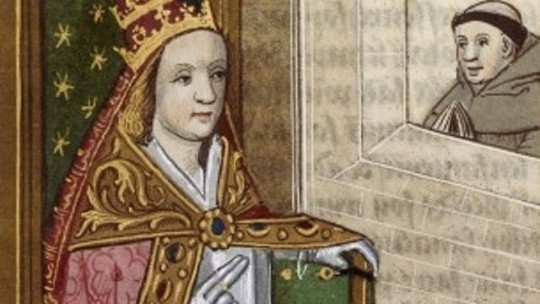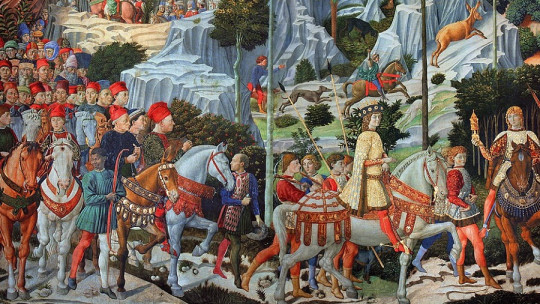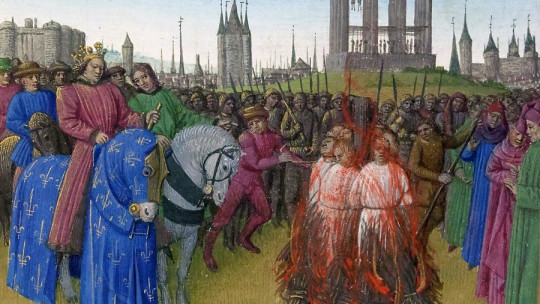We are in Rome, on a sunny day in the year 858. The pope opens a majestic procession that heads to Saint John Lateran, which is considered the oldest church in the world. A large crowd follows him, admired by the pageantry of the entourage and eager to observe the holy father up close.
Suddenly, the Pope screams and contorts in the middle of the street. At that moment, the procession is walking along a shadowy alley that connects the church of San Clemente with the Colosseum. There is a brief agitation, murmurs of concern and surprise; What happens to the pontiff? Suddenly, in the midst of the hubbub, the cry of a newborn is heard. The dad just gave birth
At that moment it is discovered that the newly chosen pontiff is, in reality, a woman. Instantly, the mob, enraged by her deception, ties the unfortunate woman to the tail of a horse so that it can drag her and stone her to death. In the place where she later buried her battered body there is an inscription that reads: Petre, pater patrum, papissa prodito partum (Peter, father of fathers, facilitated the birth of the popess).
Pope Joan: the legend of the woman who became pope
The reader may have been astonished, and no wonder. Or perhaps he already knew the story, due to the various novels and films that have been made about the event. But, at the risk of sowing some disappointment, we must deny the story: the legend of the Pope Joan, the woman who became pope, is simply a medieval hoax.
The origin of the story
It all actually began several centuries later than legend has it. In the 13th century, a series of writings appear that collect the story of the Pope Joan and begin to spread like wildfire throughout Christendom. Among all these texts we have two main sources: the one that Jean de Mailly wrote in 1255 and the one composed by Martín de Opava or Martin the Polish Twenty years later, within his Chronicle of the pontiffs and emperors.
Both one and the other were Dominican friars, an order that paid special attention from the 13th century on to denigrate the female figure , an objective that is part of a general trend of discrediting women that would end the status that women had held within the Church and in political power. We will talk about this, however, in another section; Let us now focus on the story that both Jean de Mailly and Martin de Opava tell us.
If you are a woman and want to study, dress as a man
Although there are some small differences, in general the story is the same: a young woman who manages to pursue higher education disguised as a man (knowledge was reserved for men and, more specifically, for ecclesiastics) and who, little by little, becomes climbing the ecclesiastical hierarchy until finally being elected pope. Both chroniclers also insist that The fraud was discovered due to the birth, which occurred to the supposed pope while leading a procession in Rome.
Martin of Opava is not as explicit when it comes to narrating the death of the popess (Jean de Mailly insists that she was tied to a horse’s tail and stoned to death), but he does give us more information about why and how she agreed. to the studies. Opava even calls the Pope by her name, Johannes Anglicus (John the English); He tells us that she was born in Mainz and that she accompanied his lover, a young clergyman, to Athens, with the intention of studying with him under male guise.
The two chroniclers agree on the intellectual excellence of Juan/Juana who, having professed as a monk, astonishes all scholars thanks to his wisdom. Finally, both also agree on the unfortunate end of the popess: pregnant by her former lover (whom she had never abandoned, not even when she achieved the papal tiara) and confused with the calculation of the duration of the gestation, she gave birth under the eyes of all.
Pope Joan, reality or legend?
So far, the legend, captured on paper by two chroniclers from the 13th century. In reality, the time in which the story was written is the first indication to question its veracity; If in the 9th century a pope had given birth in the middle of a procession, we can be sure that it would have been rigorously recorded for posterity.
Contrary to what we believe, during the Middle Ages everything was detailed with maximum rigor and there were many chroniclers who left testimony of what was happening, no matter how small the event in question was.
On the other hand, at the time when chroniclers suggest the existence of the popess (mid-9th century) all popes are documented, and there is no temporal gap where the supposed woman-pope can be located. If we take 855 as the possible year of Joan’s election as pontiff, we find that, in September of that same year, historical records allude to Benedict III as pope-elect. He is a pope sufficiently documented so that there is no doubt about it.
And if we go to Jean de Mailly’s chronicle and take the date that he suggests as the year of the beginning of Joan’s pontificate (1099), we also find ourselves with a dead end. Urban II died exactly that year, but just a few days later Pascual II was elected pontiff.
That is to say, we have two convincing arguments that make Juana’s theory of historicity shake. On the one hand, it is very strange that no chronicler recorded the bizarre story before the 13th century; for another, the pontificate of the popess cannot be inserted into any temporal gap because contemporary popes are duly documented.
The campaign to discredit women
But there is another clue that should warn us that the legend of Pope Joan is, quite simply, a hoax invented in the Middle Ages. And, at the time when Jean de Mailly and Martín de Opava wrote the story, a social change was taking place in Europe. And this change was none other than the discrediting of women.
Before the 13th century, women had a much more predominant status The first centuries of the Middle Ages are the centuries of powerful women; great abbesses who govern monasteries as authentic feudal ladies and ladies who administer their husbands’ property when they are absent and who even govern the fiefs of their ownership. We could cite many and varied examples that would illustrate the social position that women had in the High and Middle Ages, especially religious women and nobles.
In the middle of the 13th century, something begins to change. Roman law is recovered, which, although it has never been completely lost (remember that the Middle Ages were eminently classical), acquired renewed importance at that time. And to speak of Roman law is to speak of the paterfamilias and, therefore, of the subjection of women to the (male) head of the family and, therefore, of society.
On the other hand, we cannot forget that the philosophy of Aristotle (the misogynist thinker par excellence) penetrates strongly in Europe , especially with Arabic translations. The idea of the woman as a frustrated man then begins to acquire special strength, that is, a man’s project that failed in the womb and, because of this, is born as a woman, an “inferior” creature in every sense. (physically, intellectually and morally).
What does all this have to do with the legend of Pope Joan? Let us remember that the main chroniclers of it were Dominicans. And the Dominican order had special zeal from the 13th century onwards to present women as an “imperfect” creation of God and, therefore, a source of sin, vices and temptations. What better way to sustain the campaign to smear women through an invented story (or taken from folk tales) where a woman deceives and betrays and, therefore, in the end receives what she deserves?
The legend of Pope Joan and the Reformation
On the other hand, it is precisely in the 15th century, just before Luther’s Reformation, when the legend of Pope Joan gains unprecedented fame. History comes to the reformers like a glove to denounce the corruption of the clergy and the degradation of the Church; especially at the hands of the followers of Jan Huss (1370-1415), a Bohemian reformer, the figure of the popess merged with the Babylonian prostitute of the Apocalypse and therefore came to represent the absolute decline of the ecclesiastical institution.
The infallibility of the papacy, a doctrine strongly supported by the Catholic Church, was openly questioned by reformists, and The legend of the woman-pope was an exceptional way to illustrate his criticism Thus, Juana became the banner of the campaign to discredit women and became a vehicle for the expression of the Lutheran Reformation.
We can say, then, that the story of the woman who became pope is false. As is the famous ritual that is supposedly performed after the election of a pope. According to this hoax, the newly chosen pontiff must sit on a chair that has a central hole and place his genitals through it. Next, another clergyman carefully palpates the holy father’s testicles and exclaims: duos habet et bene pendentes (he has two, and they hang well).
Apparently, the legend originated from the story of the Pope Joan, when Word began to spread that the high dignitaries of the Church had to ensure the masculinity of the elected pope so that a woman would not “sneak” them into the Vatican again.









